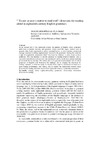Identificador persistente para citar o vincular este elemento:
https://accedacris.ulpgc.es/jspui/handle/10553/55735
| Campo DC | Valor | idioma |
|---|---|---|
| dc.contributor.author | Rodríguez Álvarez, Alicia | - |
| dc.date.accessioned | 2019-06-10T15:06:50Z | - |
| dc.date.available | 2019-06-10T15:06:50Z | - |
| dc.date.issued | 2016 | - |
| dc.identifier.issn | 2000-3560 | - |
| dc.identifier.other | WoS | - |
| dc.identifier.uri | https://accedacris.ulpgc.es/handle/10553/55735 | - |
| dc.description.abstract | In the second half of the eighteenth century the number of English school grammars underwent a dramatic increase, and grammar writers used title pages, prefaces and, in general, other book components to attract potential buyers. A very common commercial strategy consisted in adding supplementary material to the grammars. Among this material, a type of supplement, commonly called “directions for reading”, is often found in these grammars. This was intended to provide guidance on reading aloud to students, since a successful and effective oral delivery was considered a polite social asset and an important professional skill at the time. This article aims (i) to present a representative list of school grammars of English with “directions for reading”, (ii) to compare the directions for reading contained in different works to identify those aspects considered essential for a good reading performance, and, finally, (iii) to explore the relationship between these directions for reading and some works of the eighteenth-century elocutionary movement. | - |
| dc.language | eng | - |
| dc.relation | El Paratexto en Las Gramáticas Inglesas Del Siglo Xviii: Lengua y Sociedad. | - |
| dc.relation.ispartof | Moderna Sprak | - |
| dc.source | Moderna Sprak [ISSN 2000-3560], v. 110 (2), p. 105-132 | - |
| dc.subject | 5701 Lingüística aplicada | - |
| dc.subject.other | Reading aloud | - |
| dc.subject.other | Eighteenth-century grammars | - |
| dc.subject.other | Elocutionary movement | - |
| dc.subject.other | Directions for reading | - |
| dc.title | "Tis not so easy a matter to read well": directions for reading aloud in eighteenth-century English grammars | - |
| dc.type | info:eu-repo/semantics/article | - |
| dc.type | Article | - |
| dc.identifier.isi | 000393121900006 | - |
| dc.description.lastpage | 132 | - |
| dc.identifier.issue | 2 | - |
| dc.description.firstpage | 105 | - |
| dc.relation.volume | 110 | - |
| dc.investigacion | Artes y Humanidades | - |
| dc.type2 | Artículo | - |
| dc.contributor.daisngid | 3439514 | - |
| dc.description.numberofpages | 28 | - |
| dc.contributor.wosstandard | WOS:Rodriguez-Alvarez, A | - |
| dc.date.coverdate | 2016 | - |
| dc.identifier.ulpgc | Sí | es |
| dc.description.sjr | 0,101 | |
| dc.description.sjrq | Q4 | |
| dc.description.ahci | AHCI | |
| dc.description.scie | SCIE | |
| dc.description.ssci | SSCI | |
| item.fulltext | Con texto completo | - |
| item.grantfulltext | open | - |
| crisitem.project.principalinvestigator | Rodríguez Álvarez, Alicia | - |
| crisitem.author.dept | GIR IATEXT: Variación y Cambio Lingüístico | - |
| crisitem.author.dept | IU de Análisis y Aplicaciones Textuales | - |
| crisitem.author.dept | Departamento de Filología Moderna, Traducción e Interpretación | - |
| crisitem.author.orcid | 0000-0002-2595-5634 | - |
| crisitem.author.parentorg | IU de Análisis y Aplicaciones Textuales | - |
| crisitem.author.fullName | Rodríguez Álvarez, Alicia | - |
| Colección: | Artículos | |
Citas de WEB OF SCIENCETM
Citations
1
actualizado el 25-feb-2024
Visitas
19
actualizado el 11-ene-2026
Descargas
42
actualizado el 11-ene-2026
Google ScholarTM
Verifica
Comparte
Exporta metadatos
Los elementos en ULPGC accedaCRIS están protegidos por derechos de autor con todos los derechos reservados, a menos que se indique lo contrario.
